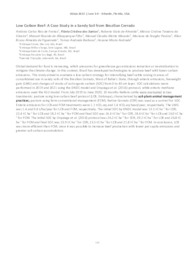Low Carbon Beef: a case study in a sandy soil from Brazilian Cerrado.
Low Carbon Beef: a case study in a sandy soil from Brazilian Cerrado.
Author(s): FREITAS, A. C. R. de; SANTOS, F. C. dos; ALMEIDA, R. G. de; SILVEIRA, M. C. T. da; ALBUQUERQUE FILHO, M. R. de; MACEDO, M. C. M.; PEREIRA, M. de A.; FIGUEIREDO, A. B. A. de; BARBOSA, T. A.; ANDRADE, H. M.
Summary: Global demand for food is increasing, which pressures for greenhouse gas emissions reduction or neutralization to mitigate the climate change. In this context, Brazil has developed technologies to produce beef with lower carbon emissions. This study aimed to evaluate a low carbon strategy for intensifying beef cattle raising in areas of consolidated use in sandy soils of the Brazilian Cerrado, West of Bahia's State, through enteric emissions, liveweight gain (LWG) and changes of stocks of soil organic carbon (SOC) from 0 to 40 cm layer. SOC calculations were performed in 2019 and 2021 using the DNDC model and Urquiaga et al. (2016) protocol, while enteric methane emissions used the ALU model.
Publication year: 2022
Types of publication: Abstract in annals or event proceedings
Unit: Embrapa Cocais
Observation
Some of Embrapa's publications are published as ePub files. To read them, use or download one of the following free software options to your computer or mobile device. Android: Google Play Books; IOS: iBooks; Windows and Linux: Calibre.
Access other publications
Access the Agricultural Research Database (BDPA) to consult Embrapa's full library collection and records.
Visit Embrapa Bookstore to purchase books and other publications sold by Embrapa.

